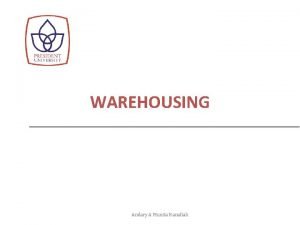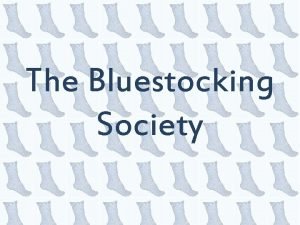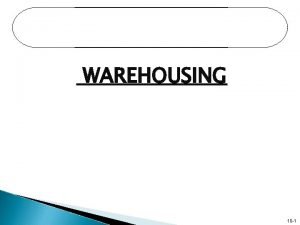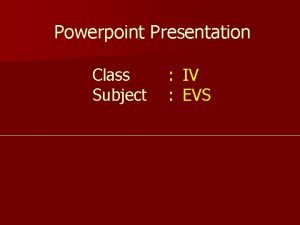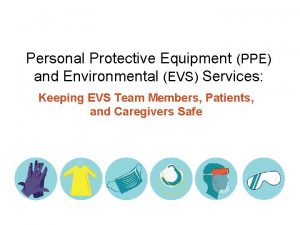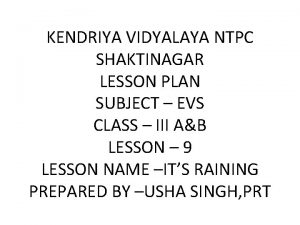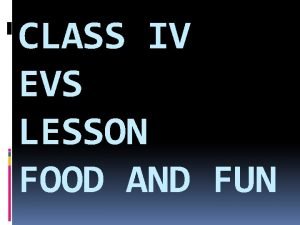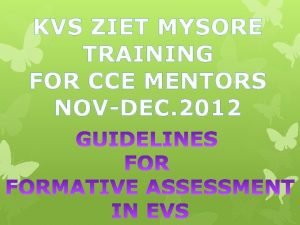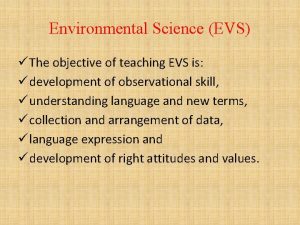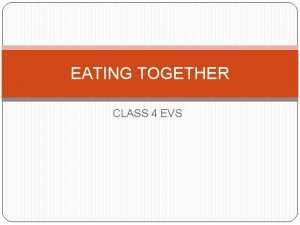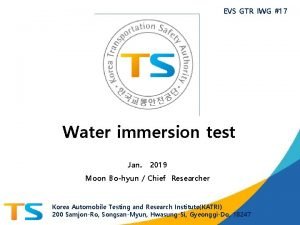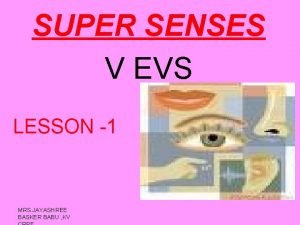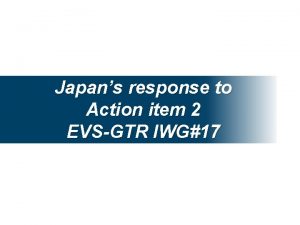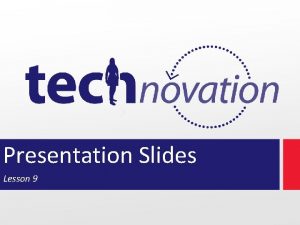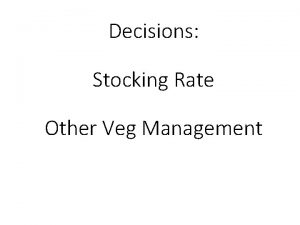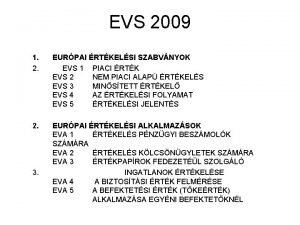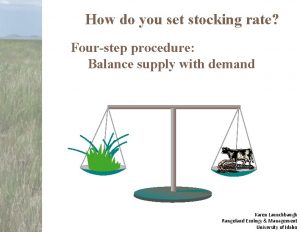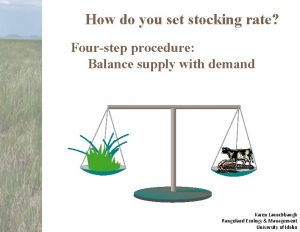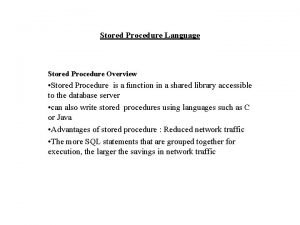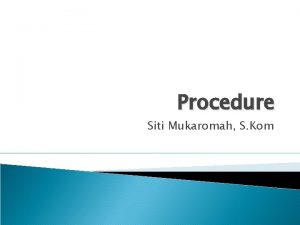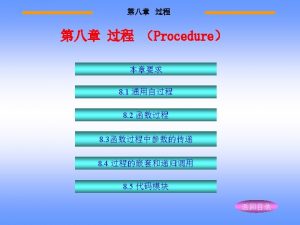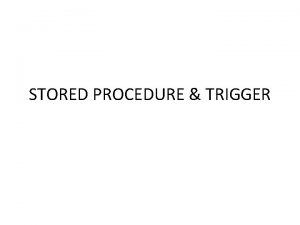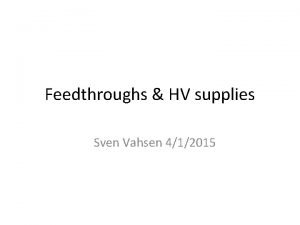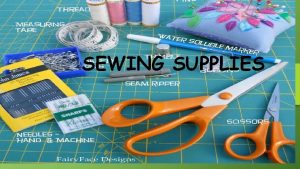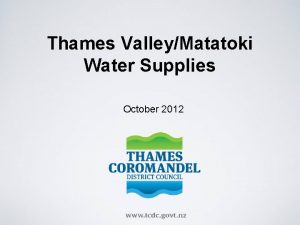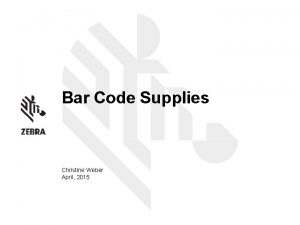Optimization of EVS Supplies Stocking Procedure Final Presentation







![Literature Review Exchange Cart & PAR Level Supply Distribution[2] • Just-in-time method Redesigning the Literature Review Exchange Cart & PAR Level Supply Distribution[2] • Just-in-time method Redesigning the](https://slidetodoc.com/presentation_image/478d1df680e09ce382c9ed7abc884c98/image-8.jpg)

































![References [1] http: //www. uofmhealth. org/maps-directions/medical-center/building-floor-maps [2] Chapter 3: OR Inventory Management. (2011). In References [1] http: //www. uofmhealth. org/maps-directions/medical-center/building-floor-maps [2] Chapter 3: OR Inventory Management. (2011). In](https://slidetodoc.com/presentation_image/478d1df680e09ce382c9ed7abc884c98/image-42.jpg)

- Slides: 43

Optimization of EVS Supplies Stocking Procedure Final Presentation IOE 481 | W 17 | Team 7 Kathy Chen, Eve Gendron, Harneet Singh, Joey Varsanik April 14, 2017

Overview • Current Process • Key Issues • Goals & Objectives • Project Scope • Project Approach • Findings & Conclusions • Recommendations • Expected Impact 1

Current Stocking Process 2

Key Issues Multiple Trips to Stockroom Inconsistent Usage Inadequate Stock Levels Inconvenient Locations Unknown Inventory Levels 3

Goals & Objectives Decrease trips to supply room 2 1 Improve Efficiency of Stocking Process Decrease instances of inadequate supplies 3 Propose methods for future study 4

Project Scope Included Excluded 21 University Tower Supply Closets Replenishing & Stocking Closets Supply Stocking Process Placing Supply Orders Schedule to maintain PAR levels Creating PAR levels Plans for Future Studies Evaluating Other Products & Closets 5

Project Approach Literature Review Data Collection Data Analysis 6
![Literature Review Exchange Cart PAR Level Supply Distribution2 Justintime method Redesigning the Literature Review Exchange Cart & PAR Level Supply Distribution[2] • Just-in-time method Redesigning the](https://slidetodoc.com/presentation_image/478d1df680e09ce382c9ed7abc884c98/image-8.jpg)
Literature Review Exchange Cart & PAR Level Supply Distribution[2] • Just-in-time method Redesigning the replenishment process with RFID[3] • E-Kanban RFID two-bin replenishment system A Guide to Improvement Projects: OR Inventory Optimization[4] • Steps to study supply stockage and usage process 7

Data Collection: Process Times Closet # Time to Stock Closet Time walking to Next Closet Time to Restock Cart Time to Stock Floor Time spent in Elevator Start Floor End Floor 8

Data Collection: Elevator Times Date/Time Building Elevator # Floors Traveled (a to b) Travel Time (from floor a to b) # of times kicked out of elevator Stock keeper 9

Key Findings Time Studies Current State Interviews & Observations 10

Time Studies: Findings Elevator Times Time to go down to Supply Room Time to go up from Stock Room Mean Time 26. 51 mins 17. 98 mins St. Dev. 11. 23 mins 11. 06 mins Max 37. 74 mins 29. 04 mins Peak Total Trip Time: ~67 mins 11

Time Studies: Findings Elevator Travel Time (n=60 hours) 8 Average Travel Time (mins) 7 6 5 4 3 2 1 0 7 am-12 pm-5 pm 5 pm-10 pm-5 am Time Period Current Stocking Period 7 am to 4 pm 12

Time Studies: Findings Elevator Times Morning (7 am – 12 pm) Afternoon (12 pm-5 pm) Evening (5 pm-10 pm) Night (10 pm-5 am) Mean Time 7 mins 4. 5 mins 2 mins 1 min St. Dev. 6 mins 3 mins 1 min 0. 5 mins Peak Total Trip Time: ~13 mins Peak Total Trip Time: ~1. 5 mins 13

Time Studies: Findings PEAK ELEVATOR TIMES Elevator Usage n=56 hours 7 6 Occurrences 5 4 3 2 1 0 8: 00 - 9: 00 -10: 00 -11: 00 -12: 00 -1: 00 -2: 00 -3: 00 -4: 00 -5: 00 Time Period 14

Time Studies: Findings Process Times Stock Closet Stock Floor Number of trips to stock room (per shift) Mean 8. 33 mins 42. 75 mins 4 trips St. Dev. 0. 15 mins 8. 73 mins 1. 63 Max 17 mins 52 mins 7 trips 15

Time Studies: Conclusions Time to Stock Room Up to 40 mins one way Elevator peak times 8 am-9 am & 11 am-1 pm Trips to Stock Room to decrease frequency Process Times Large St. Dev. due to lack of standardization 16

Current State: Findings 17

Current State: Findings EVS Management Stock Keepers Housekeepers Peak internal traffic Heaviest stocking shift Heaviest housekeeping shifts 18

Current State: Conclusions Shift Overlap Difficult to track supplies leaving closets Peak Hospital Hours Stock keepers main shift Decision Making Stock keepers make several decisions Stockouts EVS relies on Housekeepers 19

Interviews & Observations: Findings 1. EVS is not well aware of where supplies goes and how they are used 2. Stock keepers load up their carts differently 3. Stock keepers use different logic to determine when to return to the supply room • Model 1: as soon as a certain supply has run out • Model 2: once all closets have been visited 4. Stock keepers do not know how much of each stock item to stock on their carts • N = 15 hours observations, 10 hours interviews 20

Interviews & Observations: Conclusions Track Supplies System to record usage Stocking Process Need standardization Inventory System to know what is needed 21

Recommendations 1 Standardize Training 2 Switch to Night Schedule 3 Create Runner Position 4 Implement Communication System 22

Recommendation 1: Standardize Training • • EVS can create a standardized and more efficient stocking process by: • Virtual Map of Hospital • Visual Management System • Standardize Process- trips to stock room, stocking cart • Document Best Practices • Train with someone who stocks same floors • Record what goes into each closet • Video training Modules Impact: Reduces variability in stocking process 23

Recommendation 1: Standardize Training Pros Cons • Standardizes work • Requires strict based on best practices enforcement • Reduces variability of • Funding for online stock times modules and maps • Minimizes trips to stock room • Increased job satisfaction 24

Recommendation 1: Standardize Training Implementation Plan 1 • Hold Focus Groups 2 • Create Standardized Workflow 3 • Create Online Modules & Maps 4 • Retrain Stock Keepers 5 • Enforce Standardization 25

Recommendation 2: Switch Night Schedule Impact: Save ~50 minutes per shift Improved tracking of supply usage 26

Recommendation 2: Switch to Night Schedule Pros Cons • Closets full at start of housekeeping shifts • Better tracking of supply usage • Decrease time of closet stocking process • Need to adhere to quite hour regulations • Retraining/rehiring • Management has less direct oversight • Does not directly affect stockouts on off days 27

Recommendation 2: Switch to Night Schedule Implementation Plan 1 2 3 • Pilot Study • Retrain Employees • Rehire Employees (if necessary) 28

Recommendation 3: Create Runner Position • Refill stock keepers carts • Use walkie talkies to communicate • Impact: Eliminate elevator time to stock room 29

Recommendation 3: Create Runner Position Pros • Runner Absorbs Elevator Time • Stock keepers do not need to make trips to supply room Cons • Runner has to wait for elevator • Stock Keeper may have to wait on Runner • Have to hired another employee 30

Recommendation 3: Create Runner Position Implementation Plan 1 2 3 • Purchase Radios • Hire Runner • Train Runner & Stock Keepers 31

Recommendation 4: Implement Communication System • PAR Level stock inventory record sheet • Housekeepers record stock they use • Stock keepers gather inventory record sheets • Impact: Stock keepers optimize space on their carts = less trips to stock room 32

Recommendation 4: Implement Communication System 33

Recommendation 4: Implement Communication System Cont. • PAR Level stock inventory record sheet • Develop advanced online record system • Administer electronic tablets • Stock keepers record stock taken from closets Microsoft Nu. Vision TM 800 W 610 L Signature Edition Tablet [5] • House keepers review the used items • Impact: Stock keepers optimize space on carts = less trips to stock room 34

Recommendation 4: Implement Communication System Pros Cons • Stock Keepers able to • Housekeepers could fully stock more closets take advantage of the before reloading their system. cart. • Increase work for stock • Minimizes trips to stock keeper to record room inventory. 35

Recommendation 4: Implement Communication System Implementation Plan 1 2 3 • Determine PAR levels • Create appropriate record sheet • Purchase/Set Up Tablets 36

Recommendations Training Communication Impact High Night Schedule Low Runner Low High Effort 37

Expected Impact Increase Efficiency Decrease Supply Shortages Decrease Trips to Stock Room Improve Working Environment Improve Patient Experience Develop Future Study Methods 38

THANK YOU 39

SPECIAL THANKS TO: Client: Michael Alexander & EVS Team Coordinator: Jonathan Lee Instructors: Dr. Van Oyen Jai Sura 40
![References 1 http www uofmhealth orgmapsdirectionsmedicalcenterbuildingfloormaps 2 Chapter 3 OR Inventory Management 2011 In References [1] http: //www. uofmhealth. org/maps-directions/medical-center/building-floor-maps [2] Chapter 3: OR Inventory Management. (2011). In](https://slidetodoc.com/presentation_image/478d1df680e09ce382c9ed7abc884c98/image-42.jpg)
References [1] http: //www. uofmhealth. org/maps-directions/medical-center/building-floor-maps [2] Chapter 3: OR Inventory Management. (2011). In Optimizing Your Perioperative Supply Chain: A Guide to Improvement Projects. Ontario: Ontario Hospital Association. [3] Bendavid, Y. , Boeck, H. , & Philippe, R. (2010, November). Redesigning the replenishment process of medical supplies in hospitals with RFID. Retrieved from https: //www. researchgate. net/publication/243459598_Redesigning_the_replenishment_process_of_medical_supplies_in_hospi tals_with_RFID [4] Perrin, R. A. (1994). Exchange cart and par level supply distribution systems: Form follows function. Hospital Materiel Management Quarterly, 15(3), 63. Retrieved from http: //proxy. lib. umich. edu/login? url=http: //search. proquest. com/docview/234273281? accountid=14667 [5] https: //www. microsoftstore. com/store/msusa/en_US/pdp/Nu. Vision-TM 800 W 610 L-%20 Signature-Edition. Tablet/product. ID. 5078216000 [6] http: //www. uofmhealth. org/our-locations/university-hospital 41

Data Analysis: SIPOC Start: Supplies are ordered Suppliers Finished: EVS determines amount for next order Hospital Stocking Process Inputs Outputs Process Customers 1. Stock Keeper 1. Stocked Closet 1. Money 1. EVS 2. Supply Order 2. Stocked Closet 2. House Keepers 3. Outage Complaint 3. EVS Supply order is placed Supplies delivered to loading dock EVS determines amount to order Supplies transferred to supply room If outage, go and restock Supplies are organized Carts are stocked House keepers use supplies Carts are brought upstairs to closets Head to next floor Closets are stocked If need more supplies go back to stock room 42
 Pre stocking management
Pre stocking management Icon
Icon Gingrich stocking chart
Gingrich stocking chart Post stocking management
Post stocking management Stocking pond management
Stocking pond management Animal unit month calculator
Animal unit month calculator Calculate stocking rate
Calculate stocking rate Stocking density of tilapia
Stocking density of tilapia Full line stocking warehouse
Full line stocking warehouse Bluestocking society
Bluestocking society Break bulk warehouse
Break bulk warehouse What is community meal
What is community meal Animals whose ears we cannot see
Animals whose ears we cannot see Evs protection
Evs protection Evs lesson plan
Evs lesson plan Transactional strategy instruction
Transactional strategy instruction Kadhaprasad is prepared in a
Kadhaprasad is prepared in a C tech software
C tech software Evs-gtr
Evs-gtr What if it finishes class 5 evs ppt
What if it finishes class 5 evs ppt Evs competencies kvs
Evs competencies kvs General objectives of evs
General objectives of evs Eating together class 4 evs chapter
Eating together class 4 evs chapter Defence officer wahida
Defence officer wahida Tsering family
Tsering family Evs 30
Evs 30 Water immersion test method
Water immersion test method Enablers evs
Enablers evs Gtr evs
Gtr evs Evs gtr
Evs gtr Objective of water pollution
Objective of water pollution Agris koppel
Agris koppel Five super senses of tiger
Five super senses of tiger Evs-gtr
Evs-gtr Evs gtr
Evs gtr Environmental days
Environmental days Evs stands for
Evs stands for Markstrat final report
Markstrat final report Project seminar presentation
Project seminar presentation Final year project progress report
Final year project progress report Senior project presentation template
Senior project presentation template Final presentation slide
Final presentation slide Fyp presentation template
Fyp presentation template Final year project presentation
Final year project presentation








